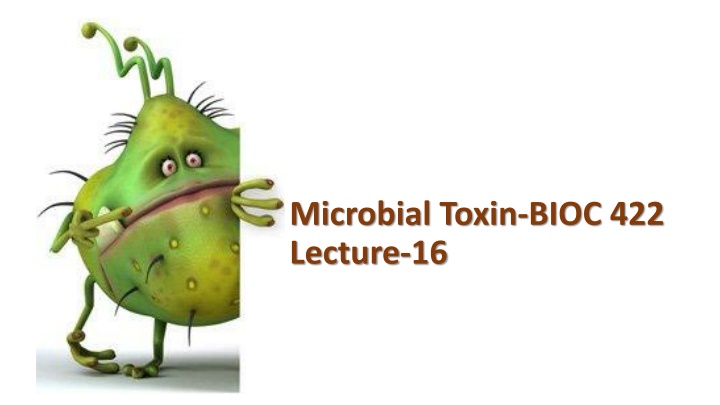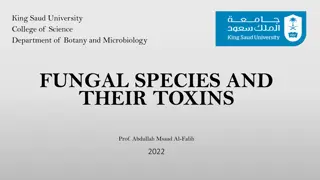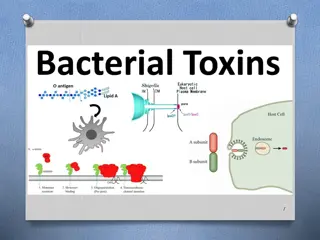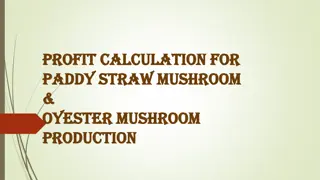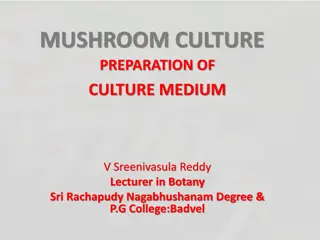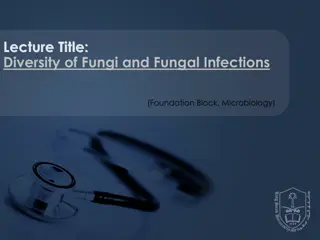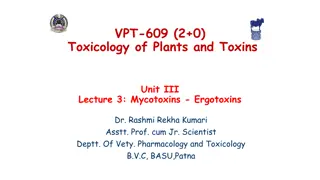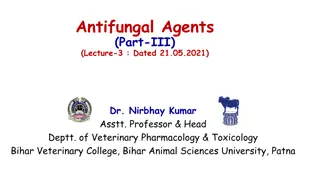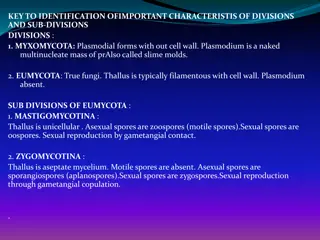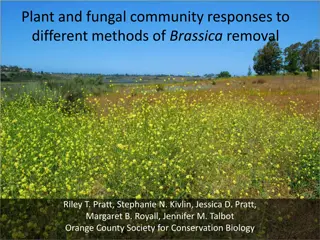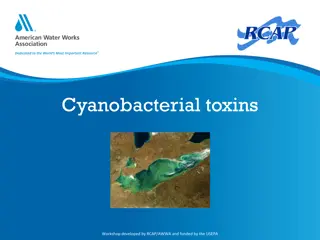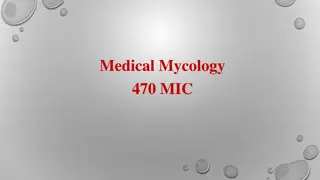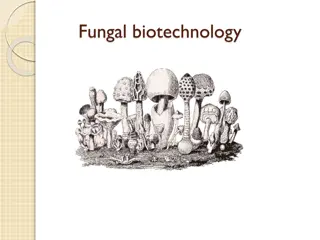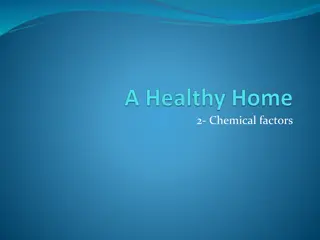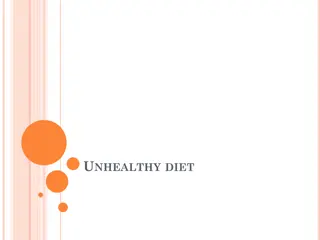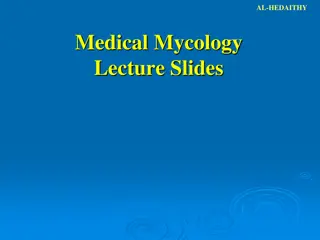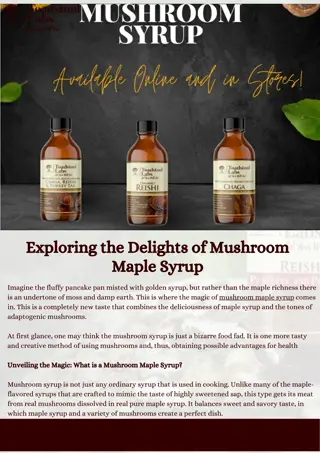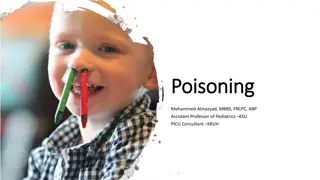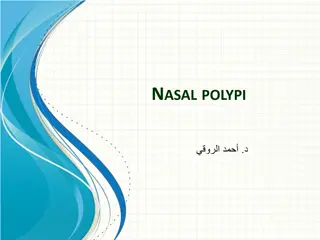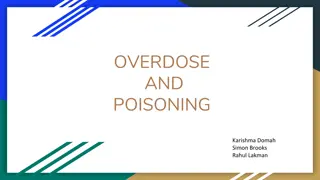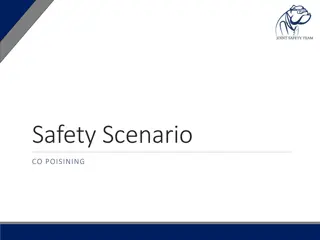Fungal Toxins and Mushroom Poisoning
Fungal toxins are categorized into mycotoxins and mushroom poisons, with varying levels of toxicity. Mushroom poisoning, known as mycetism, can result from ingesting toxic mushrooms containing harmful substances. Symptoms range from gastrointestinal discomfort to organ failure, potentially leading to death. It is essential to recognize specific mushroom toxins and their effects to prevent poisoning incidents.
Download Presentation

Please find below an Image/Link to download the presentation.
The content on the website is provided AS IS for your information and personal use only. It may not be sold, licensed, or shared on other websites without obtaining consent from the author.If you encounter any issues during the download, it is possible that the publisher has removed the file from their server.
You are allowed to download the files provided on this website for personal or commercial use, subject to the condition that they are used lawfully. All files are the property of their respective owners.
The content on the website is provided AS IS for your information and personal use only. It may not be sold, licensed, or shared on other websites without obtaining consent from the author.
E N D
Presentation Transcript
Microbial Toxin-BIOC 422 Lecture-16
3 3- - Fungal Toxins Fungal Toxins
Fungal toxins Fungal toxins Toxins from fungi are widely grouped into: toxins from moulds ("mycotoxins") toxins from higher fungi ("mushroom poisons").
2 2- - Mushroom Poisoning Mushroom Poisoning There are actually many different types of mushrooms, though. Some have stems and caps and some don't. Some mushrooms are called toadstools. >> This nickname probably came from the fact that they looked just like a perfect spot for a toad to sit! Some people believe that the term toadstool" means a mushroom that is poisonous. >> This belief may have come from the fact that many toads were considered highly poisonous. >> However, there are actually many misconceptions out there about toadstools. Not all toadstools are poisonous and not all mushrooms are safe to eat.
2 2- - Mushroom Poisoning Mushroom Poisoning Mushroom poisoning (also known as mycetism/Mycetismus ) refers to harmful effects from ingestion of toxic substances present in a mushroom. Mycetismus = Ingestion of toxic fungus (poisonous mushrooms) Mycotoxicosis = Ingestion of a TOXIN produced in food by a fungus (contaminated grains) There are thousands of species of mushrooms, but only about 100 species of mushrooms cause symptoms when eaten by humans, and only 15-20 mushroom species are potentially lethal when ingested. The toxicity of different mushrooms within the same genus may vary greatly. >> For instance, genus Amanita contains seven sections: https://www.ncbi.nlm.nih.gov/pmc/articles/PMC4057534/
2 2- - Mushroom Poisoning Mushroom Poisoning Poisonous mushrooms contain a variety of different toxins that can differ markedly in toxicity. Symptoms of mushroom poisoning may vary from slight gastrointestinal discomfort to life- threatening organ failure resulting in death. Serious symptoms do not always occur immediately after eating, often not until the toxin attacks the kidney or liver, sometimes days or weeks later. https://www.ncbi.nlm.nih.gov/pmc/articles/PMC4057534/
2 2- - Mushroom Poisoning Mushroom Poisoning There are a number of recognized mushroom toxins with specific, and sometimes deadly, effects:
2 2- - Mushroom Poisoning Mushroom Poisoning I. -(Alpha)amanitin -Amanitin is a bicyclic octapeptide which belongs to a large group of protoplasmic mushroom toxins known as amatoxins. 90% of deaths from mushroom ingestions are due to AMATOXIN, which possesses a fatality rate of up to 25% when ingested. -Amanitin is produced by different mushroom species: the green death cap mushroom* (Amanita phalloides) Fool s Mushroom*Amanita verna, The Destroying Angel* (Amanita virosa) These mushroom species, and other not listed, produce -amanitin in amounts sufficient to poison an adult person with liver damage and fatal outcome (LD50, p.o. humans; 0.1mg/kg). http://adcreview.com/adc-university/adcs-101/cytotoxic-agents/%CE%B1-amanitin/
2 2- - Mushroom Poisoning Mushroom Poisoning I. -(Alpha)amanitin Mode of Action: Alpha amanitin is known as potent inhibitor RNA polymerase >> The toxin shows remarkable binding affinity for eukaryotic RNA polymerase II, slightly binds to RNA polymerase III, and shows no activity on RNA polymerase I {RNA polymerase: is an enzyme that produces primary transcript RNA. RNA polymerase II: catalyzes the transcription of DNA to synthesize precursors of mRNA} -Amanitin binds on the back side of RNA polymerase, away from the active site and away from the binding site for the DNA and RNA. http://adcreview.com/adc-university/adcs-101/cytotoxic-agents/%CE%B1-amanitin/
2 2- - Mushroom Poisoning Mushroom Poisoning I. -(Alpha)amanitin Mode of Action: This binding does not physically block the active site, like most inhibitors, but instead jams the mechanism of the enzyme: >> RNA polymerase is a highly mobile enzyme, that flexes and changes shape as it performs the sequential steps of binding to DNA, unwinding it, and then building the RNA strand >> the poison binds between two subunits of the protein, gluing them together and blocking these essential motions. >> this will reduce the rate of polymerase translocating on DNA from several thousand to a few nucleotides per minute https://www.youtube.com/watch?v=J3HVVi2k2No http://adcreview.com/adc-university/adcs-101/cytotoxic-agents/%CE%B1-amanitin/
2 2- - Mushroom Poisoning Mushroom Poisoning I. -(Alpha)amanitin Mode of Action: the poison binds between two subunits of the protein, gluing them together and blocking these essential motions. this will reduce the rate of polymerase translocating on DNA from several thousand to a few nucleotides per minute! Since the rate of transcription is significantly slowed to this extent, the cell cannot produce mRNA transcripts at an efficient rate, ultimately destroying the cell. http://adcreview.com/adc-university/adcs-101/cytotoxic-agents/%CE%B1-amanitin/
2 2- - Mushroom Poisoning Mushroom Poisoning I. -(Alpha)amanitin Symptoms: Diarrhea and cramps are the first symptoms, but those pass, giving a false sign of remission. Typically, on the 4th to 5th day, the toxin starts to have severe effects on the liver and kidneys, leading to total system failure in both. Death usually takes place around a week from ingestion. http://adcreview.com/adc-university/adcs-101/cytotoxic-agents/%CE%B1-amanitin/
2 2- - Mushroom Poisoning Mushroom Poisoning I. -(Alpha)amanitin Use in medicine: The trial drug has shown the outstanding activity of amanitin-based ADCs in therapy-resistant tumor cells. *(Antibody-drug conjugates or ADCs are an important class of highly potent biopharmaceutical drugs designed as a targeted therapy for the treatment of people with cancer. Unlike chemotherapy, ADCs are intended to target and kill only the cancer cells and spare healthy cells. ADCs are complex molecules composed of an antibody linked to a biologically active cytotoxic (anticancer) payload or drug). -Amanitin seems to be a suitable toxic payload for use in an Antibody-drug Conjugate or ADC because of the unique mode of action and the molecular characteristics of the toxin http://adcreview.com/adc-university/adcs-101/cytotoxic-agents/%CE%B1-amanitin/
2 2- - Mushroom Poisoning Mushroom Poisoning Examples of erroneous folklore "rules" include: "Poisonous mushrooms are brightly colored." Some choice edible species are brightly colored, while most poisonous species are brown or white. "Insects/animals will avoid toxic mushrooms." Fungi that are harmless to invertebrates can still be toxic to humans; the death cap, for instance, is often infested by insect larvae. "Poisonous mushrooms blacken silver." None of the known mushroom toxins have a reaction with silver. "Poisonous mushrooms taste bad." People having eaten the deadly Amanitas reported that the mushrooms tasted quite good. "All mushrooms are safe if cooked/parboiled/dried/pickled/etc." While it is true that some otherwise-inedible species can be rendered safe by special preparation, many toxic species cannot be made toxin-free. "Poisonous mushrooms will turn rice red when boiled." this misconception cost at least one person her life. "Poisonous mushrooms have a pointed cap. Edible ones have a flat, rounded cap." The shape of the mushroom cap does not correlate with presence or absence of mushroom toxins
